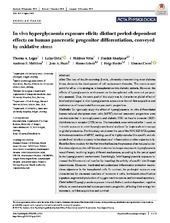| dc.contributor.author | Legøy, Thomas Aga | en_US |
| dc.contributor.author | Ghila, Luiza | en_US |
| dc.contributor.author | Vethe, Heidrun | en_US |
| dc.contributor.author | Abadpour, Shadab | en_US |
| dc.contributor.author | Mathisen, Andreas | en_US |
| dc.contributor.author | Paulo, Joao A. | en_US |
| dc.contributor.author | Scholz, Hanne | en_US |
| dc.contributor.author | Ræder, Helge | en_US |
| dc.contributor.author | Chera, Simona | en_US |
| dc.date.accessioned | 2020-07-03T12:28:26Z | |
| dc.date.available | 2020-07-03T12:28:26Z | |
| dc.date.issued | 2020 | |
| dc.Published | Legøy TA, Ghila L, Vethe H, Abadpour S, Mathisen A, Paulo JA, Scholz HS, Ræder H, Chera S. In vivo hyperglycemia exposure elicits distinct period-dependent effects on human pancreatic progenitor differentiation, conveyed by oxidative stress. Acta Physiologica. 2020;228(4):e13433 | eng |
| dc.identifier.issn | 1748-1716 | |
| dc.identifier.issn | 1748-1708 | |
| dc.identifier.uri | https://hdl.handle.net/1956/23323 | |
| dc.description.abstract | Aim: The loss of insulin‐secreting β‐cells, ultimately characterizing most diabetes forms, demands the development of cell replacement therapies. The common endpoint for all ex vivo strategies is transplantation into diabetic patients. However, the effects of hyperglycaemia environment on the transplanted cells were not yet properly assessed. Thus, the main goal of this study was to characterize global effect of brief and prolonged in vivo hyperglycaemia exposure on the cell fate acquisition and maintenance of transplanted human pancreatic progenitors. Methods: To rigorously study the effect of hyperglycaemia, in vitro differentiated human‐induced pluripotent stem cells (hiPSC)‐derived pancreatic progenitors were xenotransplanted in normoglycaemic and diabetic NSG rat insulin promoter (RIP)‐diphtheria toxin receptor (DTR) mice. The transplants were retrieved after 1‐week or 1‐month exposure to overt hyperglycaemia and analysed by large‐scale microscopy or global proteomics. For this study we pioneer the use of the NSG RIP‐DTR system in the transplantation of hiPSC, making use of its highly reproducible specific and absolute β‐cell ablation property in the absence of inflammation or other organ toxicity. Results: Here we show for the first time that besides the presence of an induced oxidative stress signature, the cell fate and proteome landscape response to hyperglycaemia was different, involving largely different mechanisms, according to the period spent in the hyperglycaemic environment. Surprisingly, brief hyperglycaemia exposure increased the bihormonal cell number by impeding the activity of specific islet lineage determinants. Moreover, it activated antioxidant and inflammation protection mechanisms signatures in the transplanted cells. In contrast, the prolonged exposure was characterized by decreased numbers of hormone + cells, low/absent detoxification signature, augmented production of oxygen reactive species and increased apoptosis. Conclusion: Hyperglycaemia exposure induced distinct, period‐dependent, negative effects on xenotransplanted human pancreatic progenitor, affecting their energy homeostasis, cell fate acquisition and survival. | en_US |
| dc.language.iso | eng | eng |
| dc.publisher | Wiley | eng |
| dc.rights | Attribution-NonCommercial CC BY-NC | eng |
| dc.rights.uri | http://creativecommons.org/licenses/by-nc/4.0/ | eng |
| dc.title | In vivo hyperglycemia exposure elicits distinct period-dependent effects on human pancreatic progenitor differentiation, conveyed by oxidative stress | en_US |
| dc.type | Peer reviewed | |
| dc.type | Journal article | |
| dc.date.updated | 2020-01-10T15:10:33Z | |
| dc.description.version | publishedVersion | en_US |
| dc.rights.holder | Copyright 2019 The Author(s) | |
| dc.source.articlenumber | e13433 | |
| dc.identifier.doi | https://doi.org/10.1111/apha.13433 | |
| dc.identifier.cristin | 1769925 | |
| dc.source.journal | Acta Physiologica | |
| dc.relation.project | Norges forskningsråd: 262613 | |
| dc.identifier.citation | Acta Physiologica. 2020, 228, e13433. | |
| dc.source.volume | 228 | |

